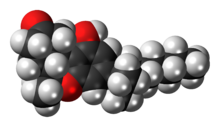
Back نابيلون (دواء) Arabic نابیلون AZB Nabilona Catalan Nabilon Welsh Nabilon German Nabilona Spanish نابیلون Persian Nabiloni Finnish Nabilone French Nabilon Croatian
 | |
 Top: (R,R)-(−)-nabilone, Center: (S,S)-(+)-nabilone, Bottom: Space-filling model of (R,R)-(−)-nabilone | |
| Clinical data | |
|---|---|
| Trade names | Cesamet, Canemes |
| AHFS/Drugs.com | Monograph |
| MedlinePlus | a607048 |
| Routes of administration | By mouth (capsules) |
| Drug class | Cannabinoid |
| ATC code | |
| Legal status | |
| Legal status |
|
| Pharmacokinetic data | |
| Bioavailability | 20% after first-pass by the liver |
| Protein binding | similar to THC (±97%) |
| Elimination half-life | 2 hours, with metabolites around 35 hours |
| Identifiers | |
| |
| CAS Number | |
| PubChem CID | |
| DrugBank | |
| ChemSpider | |
| UNII | |
| KEGG | |
| ChEMBL | |
| ECHA InfoCard | 100.164.824 |
| Chemical and physical data | |
| Formula | C24H36O3 |
| Molar mass | 372.549 g·mol−1 |
| 3D model (JSmol) | |
| |
| |
| (verify) | |
Nabilone, sold under the brand name Cesamet among others, is a synthetic cannabinoid with therapeutic use as an antiemetic and as an adjunct analgesic for neuropathic pain.[1][2] It mimics tetrahydrocannabinol (THC), the primary psychoactive compound found naturally occurring in Cannabis.[3]
The Food and Drug Administration in the United States has indicated nabilone for chemotherapy-induced nausea/vomiting. In other countries, such as Canada, it is widely used as an adjunct therapy for chronic pain management. Numerous trials and case studies have demonstrated modest effectiveness for relieving fibromyalgia[4] and multiple sclerosis.[5][6]
- ^ "Nabilone - AdisInsight".
- ^ "Nabilone Advanced Patient Information".
- ^ "Nabilone label" (PDF). FDA. May 2006.
- ^ Cite error: The named reference
painwas invoked but never defined (see the help page). - ^ Wissel J, Haydn T, Müller J, Brenneis C, Berger T, Poewe W, Schelosky LD (October 2006). "Low dose treatment with the synthetic cannabinoid Nabilone significantly reduces spasticity-related pain : a double-blind placebo-controlled cross-over trial". Journal of Neurology (Research article). 253 (10): 1337–41. doi:10.1007/s00415-006-0218-8. PMID 16988792. S2CID 24206300.
- ^ Nielsen S, Germanos R, Weier M, Pollard J, Degenhardt L, Hall W, Buckley N, Farrell M (February 2018). "The Use of Cannabis and Cannabinoids in Treating Symptoms of Multiple Sclerosis: a Systematic Review of Reviews". Current Neurology and Neuroscience Reports. 18 (2): 8. doi:10.1007/s11910-018-0814-x. hdl:2123/18910. PMID 29442178. S2CID 3375801.
© MMXXIII Rich X Search. We shall prevail. All rights reserved. Rich X Search